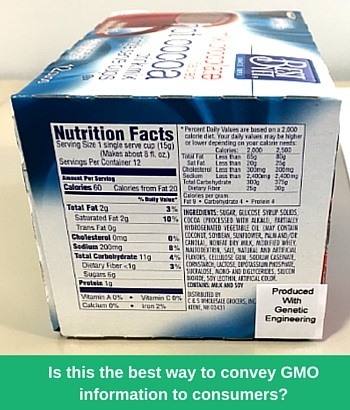By: Leslie Sarasin, President and CEO, Food Marketing Institute

The following is a transcript from Sarasin’s participation at a press conference with the Coalition For Safe Affordable Food stressing urgency of Senate action on national GMO labeling and costs of inaction.
As the spokesperson for the nation’s food retailers, it’s pretty much second nature for me to point to lots of different examples of the ways grocery stores are meeting shoppers’ needs each and every day by selling safe, affordable, nutritious food.
You may be aware that, on average, grocery stores carry 42,000 distinct products, and grocers customize the offerings they merchandise to constantly compete for, attract and delight individual shoppers, all of whom have different needs and desires when it comes to such a personal part of their lives as food is.
And just as shoppers aren’t all the same in what they seek when they buy food, it’s important to remember that shoppers consume information differently as well. It’s equally critical to point out that primary to everything we do in our business, we serve our customers.
So, for all of us, satisfying our shared ultimate customer is our end goal with participating in the debate and the legislative process on GMO labeling. Allowing a state-by-state patchwork of differing laws to regulate the way products containing ingredients derived from agriculture biotechnology will have the exact opposite effect of what we’re trying to accomplish in that it will confuse consumers by offering incomplete and even potentially conflicting guidance to them.
For instance, it’s not at all unusual for one distribution center to service five or more states, so Vermont's law, and those expected to come from Maine, Massachusetts, and other states in that region, will quickly make New England’s food labeling laws so fragmented that a simple granola bar will be required to be labeled five different ways to meet the requirements of the various jurisdictions. So, as consumers move among these neighboring states, they will have inconsistency in labeling of something as common as a granola bar. Imagine the confusion when that’s multiplied by 42,000 items in an average grocery store!
So I would stress today that Congress has an incredible opportunity in front of it that’s pro-consumer, pro-business and pro-farmer: They can author a new information era for consumers that meets shoppers wherever they are, with the information they seek.
In this digital age, shoppers expect customization, which necessitates flexibility in messaging. All we’re asking for is to be allowed in this country to give consumers consistent and complete information they want, and in the way they are best prepared to receive it, whether it’s via a 1-800 number, a mobile device or desktop computer, or a SmartLabel QR code - a solution that will give consumers more product information than would ever be possible on a label.
We learned through FMI’s U.S. Grocery Shopper Trends 2016 research that 20 percent of shoppers already scan QR codes or traditional barcodes of grocery items to learn more about their nutritional value, and that an additional 36 percent are interested in doing so. This trend demonstrates technology’s increased role in the shopping experience and the diversity of ways shoppers obtain data on products.
Still, no matter the channel, consistent information is crucial for the customer. In this increasingly mobile society we live in, to do otherwise just doesn’t make any sense. What you’re hearing this morning from all of us is that the food chain is aligned in its desire for a national standard for the labeling of food products containing GMO’s. To that end, we strongly urge Senators Roberts and Stabenow to reach an agreement regarding a national standard for GMO labeling and that the Senate and the House move the measure forward expeditiously.


 Industry Topics address your specific area of expertise with resources, reports, events and more.
Industry Topics address your specific area of expertise with resources, reports, events and more.
 Our Research covers consumer behavior and retail operation benchmarks so you can make informed business decisions.
Our Research covers consumer behavior and retail operation benchmarks so you can make informed business decisions.
 Events and Education including online and in-person help you advance your food retail career.
Events and Education including online and in-person help you advance your food retail career.
 Food Safety training, resources and guidance that help you create a company food safety culture.
Food Safety training, resources and guidance that help you create a company food safety culture.
 Government Affairs work — federal and state — on the latest food industry policy, regulatory and legislative issues.
Government Affairs work — federal and state — on the latest food industry policy, regulatory and legislative issues.
 Get Involved. From industry awards to newsletters and committees, these resources help you take advantage of your membership.
Get Involved. From industry awards to newsletters and committees, these resources help you take advantage of your membership.
 Best practices, guidance documents, infographics, signage and more for the food industry on the COVID-19 pandemic.
Best practices, guidance documents, infographics, signage and more for the food industry on the COVID-19 pandemic.
